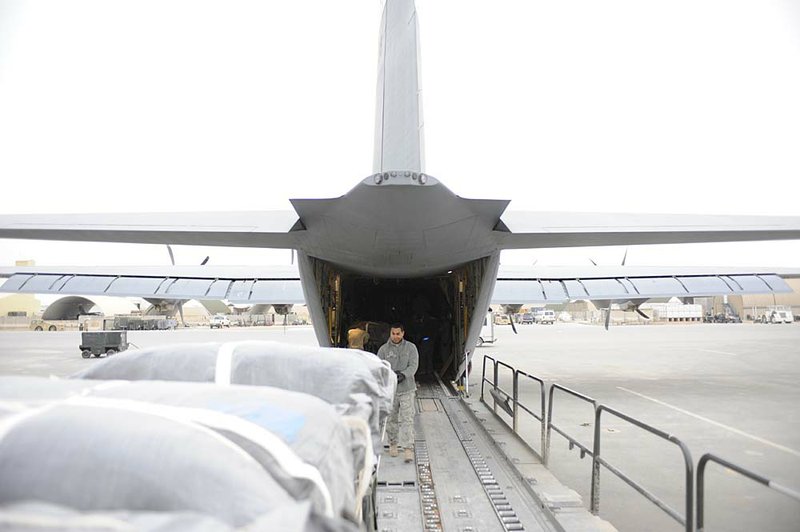LITTLE ROCK — Little Rock Air Force Base’s 41st Airlift Squadron broke another airdrop record in Afghanistan last month, dropping more than 1.5 million pounds of supplies to ground troops as operations in the war zone continue to expand.
“And we’re already on pace to break the record again,” Lt. Col. Doug Delamater, commander of the 41st, said Thursday.
The 772nd Expeditionary Airlift Squadron began operations out of Kandahar AirBase in southern Afghanistan in 2009 and has been primarily staffed by 41st planes and airmen with help from other units assigned to Little Rock Air Force Base’s 19th Airlift Wing. It is not the only airlift squadron in Afghanistan, with C-130s operating out of Bagram and C-17s making airdrops in the region as well.
But over time, the 41st has proved to be the busiest, flying the C-130J - the model currently rolling off Lockheed Martin’s assembly line.
And that pace is expected to increase this summer when the 772nd doubles its size interms of planes and people. The entire 41st will deploy there in May with a tactics specialist from the 314th Airlift Wing and two former 41st members who moved on to Dyess Air Force Base to help build the nation’s newest C-130J squadron.
“The demand for airlift increases as the summer ramps up in activity in Afghanistan,” Delamater said. “That indicates that we need to be ready to continue those record-breaking operations. And we are ready to do that. That’s why we’re doubling the strength that we previously deployed.”
This will be the first fullunit deployment of the 41st since its activation at Little Rock Air Force Base in April 2007 with 10 pilots and just one plane. In February 2008, the 41st began what has been a continual deployment rotation of its airmen and planes to Afghanistan. The entire unit has not been home since.
“This full-unit deployment indicates that we are finally becoming a fully sustainable combat unit. We’ve been in combat since 10 months after the unit was stood up, before we were fully mature,” Delamater said. “And this is a sign that we are actually reaching maturity. We are finally catching up.”
The squadron was able to take a partial break from deployments with the help of units such as Little Rock’s 50th Airlift Squadron and the 19th Airlift Wing’s active associate units in Colorado Springs, Colo.; Cheyenne, Wyo.; and most recently Keesler Air Force Base, Miss.
The 86th Airlift Wing in Ramstein Air Base, Germany, became a fully functioning C-130J unit last fall and was initially scheduled to replace the 41st at the 772nd in January. But that didn’t happen and the 86th is nowhere in the Afghanistan deployment rotation this year.
So the 41st will continue to carry the load and will eventually get help from the 317th Airlift Group at Dyess Air Force Base, Texas, who will be joining the rotation laterin the year as it builds its new C-130J fleet.
The C-130J has proved its worth in Afghanistan’s harsh environment. With six props on its four Rolls-Royce engines, digital flight controls and satellite communication and navigation systems, the J-model can fly higher, faster, farther and carry more than older models.
And demand has never been higher, with airdrop operations at the highest levels since the Vietnam War. The annual airdrop poundage has doubled every year since 2006, according to the U.S. Air Force Central Combined Air and Space Operations Center.
In 2006, 3.5 million pounds of cargo was airdropped in Iraq and Afghanistan. The majority of those drops were in Afghanistan. In 2010, 60.4 million pounds were dropped. So far this year, more than 18.6 million pounds.
“It’s rewarding to get up every day and be part of a team supplying the troops outside the wire,” 1st Lt. Roger Knobelock, a co-pilot with the 41st, said in an Air Force release about the record. “It's pretty cool breaking records as well.”
The previous airdrop record in Afghanistan was set by the 772nd in January. It flew 51 airdrop missions that month. In March, the squadron flew 72 airdrop missions dropping 1,100 bundles - 1.5 million pounds - of ammunition, fuel, water and food to ground troops fighting in isolated mountain valleys.
“It’s what this airplane was built for and it’s what the nation has spent so much of its treasure on to ensure thatour nation can do,” Delamater said. “And we are the ones lucky enough to get to operate this [plane] at the tip of the spear. It is why we exist.”
Little Rock Air Force Base in Jacksonville is the largest C-130 Hercules base in the world. It has more than 100 planes in its inventory and is home to the world’s primary C-130 school. The 314th Airlift Wing trains all Hercules crews across the nation’s military and that of more than 44 allied nations while the 19th Airlift Wing deploys to hot spots around the world.
The March airdrop record was reached with the help of the 19th’s newest active associate unit, the 345th Airlift Squadron, and the 815th Airlift Squadron of the Air Force Reserve. The 345th and 815th share aircraft at Keesler Air Force Base and sent a few crews and planes to Afghanistan with the 41stthis winter.
The 772nd, with maintenance personnel from both Little Rock Air Force Base and Keesler Air Force Base, has had one of the best maintenance rates as well, according to Capt. Penny Carroll, 451st Air Expeditionary Wing spokesman. The 772nd has had 255 straight missions without a cancellation for maintenance problems.
“Making this record was really a whole team concept,” said Master Sgt. Michael Warlick, a maintainer for the 772nd. “Every single person in this [maintenance unit] played a vital part, from all of maintenance and all of [operations]. Without all these people melding together, we could not have achieved this goal.”
Front Section, Pages 1 on 04/11/2011

